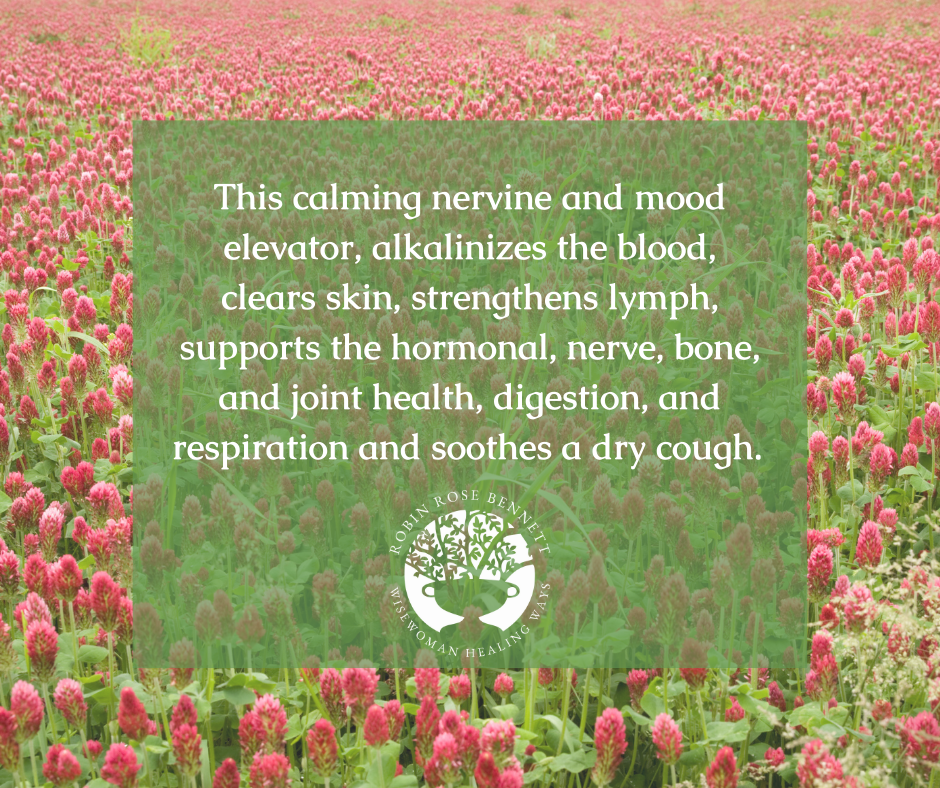Crimson Clover, over and over…
Let’s talk about darling Red Clover….
Body: alkalinizes blood, clears skin, strengthens lymph, supports hormonal, nerve, bone, and joint health, digestion, and respiration.
Mind: stabilizes the mind.
Heart: calms and soothes the emotions.
Soul: opens the connection between body and soul.
Hello friends!
Trifolium pratense is the botanical name of red clover, a perennial plant in the pea family and refers to what she looks like and where she lives. Red clover has sets of three leaves (tri-folium) and is most happily found in meadows (pratense).
Red clover is the national flower of Denmark and the state flower of Vermont. Though I’ve never yet gathered her blossoms in Denmark, without question the most beautiful red clover I’ve ever gathered was in Vermont with my first apprentice, Martha. Please read on to meet red clover so that you can discover that she’s not really red, and a whole lot more.
Red clover is a beautiful member of the legume family, gentle and strong, with glistening pink-to-purple hairy blossoms, exquisitely patterned sepals, and white chevrons on the leaves. She grows abundantly in open fields, and blossoms in the early part of the summer. Found in healthy meadows and also in disturbed soils, red clover is a valuable medicine. Red clover benefits the whole body, especially the lymphatic, digestive, female reproductive, musculoskeletal, nervous, and integument systems (skin). This is a classic “alterative,” a plant known to reliably improve long-standing chronic conditions over time.
This special plant is rich in all of the standard amino acids that form the building blocks of protein, which are the building blocks of life. Protein is found in all of our cells and is second only to water as the most essential nutrient for the human body.
Red clover provides an easily digestible, complete protein that can help a person who is convalescing from a long illness and having trouble eating enough food to maintain their health and strength. It can also be a blessing when someone near the end of life has lost interest in food.
Make it stand out
The first time I saw this was many years ago when a friend of mine was in the last stages of an AIDS-related illness. He asked me to stop bringing him anything except red-clover infusions. They soothed him mentally and physically, and he had no trouble drinking them even after his desire for other food and drink was gone. The amino acids in red clover also provide our bodies with the material to create neurotransmitters, such as serotonin and dopamine, to help maintain a healthy, stable state of mind. Red clover provides optimum nourishment, providing vitamin B complex, vitamin C, calcium, chromium, magnesium, manganese, niacin, phosphorus, and potassium.
I use red clover to help balance the acid/alkaline levels in the body. This is useful for challenges including chronic heartburn, arthritis, and both acute and chronic skin rashes. It is a gentle and safe herb for children with eczema. Red clover is also helpful for hormonal health, reversing premature menopause, for example, and easing menstrual cramps and other discomforts. It is one of the herbs that a woman can call on to help dissolve cystic breast lumps. Red clover is a supremely nourishing tonic that improves both physical form (blood, tissue and bones) and function (assimilation, elimination and filtering through the digestive system, skin, lymph, and lungs).
You can eat fresh red clover blossoms! They are sweetest and most delicious when you pull out the individual “petals” (which are actually complete flowers in and of themselves) from the bushy flower head, and strew them atop your salad, veggies, open-faced sandwich, or even as a colorful garnish over an omelet!
The way I use red clover most frequently when the plant is not in season/flowering is to make an infusion of the dried flower heads. Most flowers are delicate and don’t have to be steeped for a long time to draw out their healing properties, but red clover is dense, so I make a long-steeping infusion to get the full benefits.
Below are two easy recipes for Red Clover Infusion and Red Clover Blossom Oil…
Red Clover Infusion
Dried red clover blossoms – 1 ½ - 2 cups
Boiling water – 1 quart
1 quart jar with a tightly fitting lid
Put your dried blossoms into the jar. Cover with boiling water. Top up with more of the boiled water a couple of times to fill it as full as possible, then cap the jar tightly and let it sit on your counter for 4-8 hours. I usually steep mine overnight.
When the infusion is ready, pour the herbs through a strainer and be sure to squeeze the blossoms, as you may get as much as another ½ cup of herbal medicine that way! This yields the strongest part, too, so it will make your infusion tastier and more effective. You definitely don’t need to be sick to drink red clover. It is so rich in vitamins and minerals that it is a primary nourishing herb. This infusion can be enjoyed at room temperature, iced, or re-heated.
Remember to refrigerate any portion you’re not drinking right away, or the high protein content will cause it to go “off” in the summer heat.
Finally, of course you can blend red clover with other herbs, and I share some of my favorite recipes in The Gift of Healing Herbs, but do try this solo remedy, too. In herbal medicine this is called a “simple” (though it’s actually quite complex, like any other being) and you will get to know red clover best this way!
I hope you are able to find some red clover growing in your area and explore her wonderful healing properties…
Green Blessings,
Robin Rose





